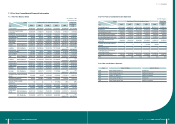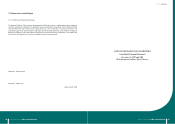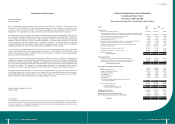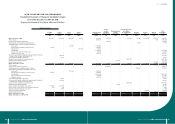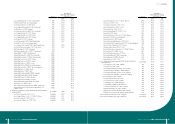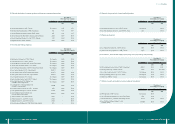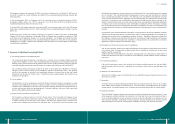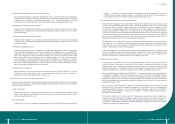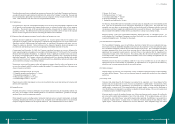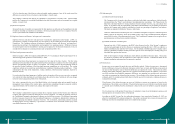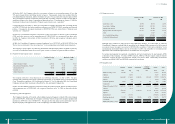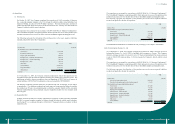Acer 2008 Annual Report Download - page 38
Download and view the complete annual report
Please find page 38 of the 2008 Acer annual report below. You can navigate through the pages in the report by either clicking on the pages listed below, or by using the keyword search tool below to find specific information within the annual report.
Acer Incorporated 2008 Annual Report72
Financial Standing
Acer Incorporated 2008 Annual Report 73
The Company completed the acquisition of 100% of the shares of Gateway, Inc. on October 15, 2007 (refer to
note 4(14)). Gateway, Inc. and its subsidiaries are included in the consolidated nancial statements from the date
of the acquisition.
In July and September 2007, the Company sold all its ownership interest in Sertek Incorporated (“SNX”)
and Digital Computer System Co. (“DCS”), respectively. As a result, SNX and DCS are excluded from the
consolidated nancial statements from the dates of sale.
In October 2007, the Company reduced its investment in AMT to an ownership interest of less than 50% and no
longer held a controlling interest in AMT. AMT is excluded from the consolidated nancial statements from the
date of sale.
In March and June of 2008, the Company completed its acquisition of 100% of the shares of PB Holding
Company S.A.R.L and its subsidiaries. In September 2008, the Company also completed its acquisition of 100%
of the shares of E-ten Information System Co., Ltd. and its subsidiaries. The Company has included the results
of operations of the acquired business in the consolidated nancial statements as of the date of each acquisition.
Additionally, the Company established new subsidiaries AGP and AAPH. In November 2008, ACCSI merged
with TWP and its subsidiaries.
2. Summary of Signicant Accounting Policies
(1) Accounting principles and consolidation policy
The consolidated financial statements are prepared in accordance with accounting principles generally
accepted in the Republic of China. These consolidated nancial statements are not intended to present the
nancial position and the related results of operations and cash ows of the Consolidated Companies based on
accounting principles and practices generally accepted in countries and jurisdictions other than the ROC.
The consolidated financial statements include the accounts of the Company and subsidiaries in which the
Company is able to exercise control over the subsidiary’s operations and nancial policies. The operating
activity of the subsidiary is included in the consolidated statements of income from the date that control
commences until the date that control ceases. All significant inter-company balances and transactions are
eliminated in consolidation.
(2) Use of estimates
The preparation of the accompanying consolidated financial statements requires management to make
estimates and assumptions that affect the reported amounts of assets and liabilities and disclosures of
contingent assets and liabilities at the date of the consolidated nancial statements and reported amounts of
revenues and expenses during the reporting periods. Economic conditions and events could cause actual
results to differ signicantly from such estimates.
(3) Foreign currency transactions and translations
The Company’s reporting currency is the New Taiwan dollar. The Consolidated Companies record
transactions in their respective functional currencies, which generally are the local currency of the primary
economic environment in which these entities operate. Non-derivative foreign currency transactions are
recorded at the exchange rates prevailing at the transaction date. At the balance sheet date, monetary assets
and liabilities denominated in foreign currencies are translated into New Taiwan dollars using the exchange
rates on that date. The resulting unrealized exchange gains or losses from such translations are reflected
in the accompanying statements of income. Non-monetary assets and liabilities denominated in foreign
currency that are measured in terms of historical cost are translated using the exchange rate at the date of the
transaction. Non-monetary assets and liabilities denominated in foreign currency that are measured at fair
value are reported at the rate that was in effect when the fair values were determined. Subsequent adjustments
to carrying values of such non-monetary assets and liabilities, including the effects of changes in exchange
rates, are reported in prot or loss for the period, except that if movement in fair value of a non-monetary item
is recognized directly in equity, any foreign exchange component of that adjustment is also recognized directly
in equity.
In preparation of the consolidated nancial statements, a remeasurement of the foreign subsidiaries’ nancial
statements into the functional currency is performed rst, and the remeasuring differences are accounted for as
exchange gains or losses in the accompanying statements of income. Translation adjustments resulting from
the translation of foreign currency nancial statements into the Company’s reporting currency and a monetary
item that forms part of the Company’s net investment in a foreign operation are accounted for as translation
adjustment, a separate component of stockholders’ equity.
(4) Classication of current and non-current assets and liabilities
Cash or cash equivalents, and assets that will be held primarily for the purpose of being traded or are expected
to be realized within 12 months after the balance sheet date are classied as current assets; all other assets
shall be classied as non-current.
Liabilities that will be held primarily for the purpose of being traded or are expected to be settled within 12
months after the balance sheet date are classied as current liabilities; all other liabilities shall be classied as
non-current.
(5) Cash and cash equivalents
Cash and cash equivalents consist of cash on hand, cash in banks, miscellaneous petty cash, and other highly
liquid investments which do not have a signicant level of market or credit risk from potential interest rate
changes.
(6) Allowance for doubtful accounts
Allowance for doubtful accounts is provided based on the collectibility, aging and quality analysis of notes
and accounts receivable.
(7) Inventories
Inventories for the Acer brand information technology business group are stated at the lower of cost or market
value. Market value represents net realizable value. Costs of inventory are determined using the weighted-
average method. For channel business, costs of inventory are determined using the rst-in, rst-out method.
(8) Financial instruments
The Consolidated Companies adopted transaction-date accounting for nancial instrument transactions. Upon
initial recognition, nancial instruments are evaluated at fair value plus, in the case of a nancial instrument
not at fair value through prot or loss, transaction costs that are directly attributable to the acquisition or issue
of the financial instrument. Subsequent to initial recognition, financial instruments are classified into the
following categories in accordance with the purpose of holding or issuing of such nancial instruments:



